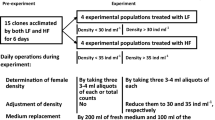Abstract
Populations of the rotifer Brachionus plicatilis were monitored in three small ponds in a marsh on the Mediterranean coast. Samples were taken approximately every three weeks from July 1992 to November 1993. Salinity, temperature, conductivity, pH and oxygen concentration were measured in the field. Population density was determined from preserved quantitative samples. Individuals were classified as mictic females, amictic females, non-ovigerous females, and males, differentiating between two morphotypes (‘S’ and ‘L’). From these counts, a level of mixis was calculated. We also determined the proportion of mictic females in natural populations by culturing females isolated from fresh samples. From these data, mictic patterns over time and correlation between levels of mixis and environmental and population parameters were analyzed. From a previous study ‘S’ and ‘L’ morphotypes were known to correspond to genetically different clonal groups. Our data showed that reproduction was predominantly parthenogenetic in these clonal groups, but mictic females were found in most samples, the proportion of mictic females ranging from 0 to 29%. The clonal groups showed different patterns of mixis. L clonal group presented a continuous sexual reproductive pattern. In contrast, S clones showed a rather punctuated mictic pattern. A positive correlation between levels of sexual reproduction and population density was found for S and L groups. However, they differed in their density threshold for mictic reproduction. The adaptive meaning of these patterns and their implications in maintaining genetic diversity within and between populations are discussed.
Similar content being viewed by others
References
Bogoslavsky, A. S., 1963. Materials to the study of the resting eggs of rotifers. Communication I. Bull. Mosk. Obshch. Ispyt. Prir. 68: 50–67.
Buchner, H., 1941. Experimentelle Untersuchungen über den Generationswechsel der Rädertiere. II. Zool. Jahrb. Abt. Allg. Zool. Physiol. 60: 279–344.
Carmona, M. J., M. Serra & M. R. Miracle, 1993. Relationships between mixis in Brachionus plicatilis and preconditioning of culture medium by crowding. Hydrobiologia 255/256 (Dev. Hydrobiol. 83): 145–152.
Gilbert, J. J., 1974. Dormancy in rotifers. Trans. am. Micros. Soc. 9: 490–513.
Gilbert, J. J., 1977. Mictic-female production in monogonont rotifers. Arch. Hydrobiol. Beih. 8: 142–155.
Gómez, A. & M. Serra, 1995. Behavioral reproductive isolation among sympatric strains of Brachionus plicatilis Müller, 1786: insights into the status of this taxonomical species. Hydrobiologia 313/314 (Dev. Hydrobiol. 109): 111–119.
Gómez, A., M. Temprano & M. Serra, in press. Population structure of the cyclical parthenogen rotifer Brachionus plicatilis in small temporal ponds. J. evol. Biol.
Guillard, R. L. & J. H. Ryther, 1962. Studies of marine planktonic diatoms.I. Cyclotella nana Hustedt and Detonula confervacea (Cleve). Can. J. Microbiol. 8: 229–239.
Halbach, U. & G. Halbach-Keup, 1972. Einfluss von Aussenfaktoren auf den Fortpflanzungsmodus heterogener Rotatorien. Oecologia 9: 203–214.
Hino, A. & R. Hirano, 1976. Ecological studies on the mechanism of bisexual reproduction in the rotifer Brachionus plicatilis. I. General aspects of bisexual reproduction inducing factors. Bull. Jap. Soc. Sci. Fish. 42: 1093–1094.
Hirayama, K., 1985. Biological aspects of the rotifer Brachionus plicatiils as a food organism for mass culture of seedling. Coll. fr. japon. Océanogr., Marseille 16–21 Sept. 85, 8: 41–50.
Ito, T., 1960. On the culture of the mixohaline rotifer Brachionus plicatilis Müller in sea water. Rep. Fac. Fish. Prefect. Univ. Mie 3: 708–740.
Ito, T. & T. Iwai, 1958. Studies on the ‘Mizukawari’ in eel-culture ponds. VIII. ‘Mizukawari’ phenomena occurred in six eel-culture ponds near Tsu City, Mie Prefecture in (1955). Rep. Fac. Fisheries Prefect Univ. Mie 3 122–158.
Ito, S., H. Sakamoto, M. Hori & K. Hirayama, 1981. Morphological characteristics and suitable temperature for the growth of several strains of the rotifer Brachionus plicatilis. Bull. Fact. Fish. Nagasaki University 51: 9–16.
King, C. E., 1980. The genetic structure of zooplankton populations. In: W. C. Kerfoot, (ed.), Evolution and ecology of zooplankton communities. University Press of New England, Hanover, N.H: 315–328.
King, C. E. & T. W. Snell, 1980. Density-dependent sexual reproduction in natural populations of the rotifer Asplanchna girodi. Hydrobiologia 73 (Dev. Hydrobiol. 1): 149–152.
Lubzens, E., G. Minkoff & S. Marom, 1985. Salinity dependence of sexual and asexual reproduction in the rotifer Brachionus plicatilis. Mar. Biol. (Berl.) 85 123–126.
Miracle, M. R. & A. Guiset, 1977. Some effects of enclosure on congeneric species of rotifers. Arch. Hydrobiol. Beih. 8: 94–97.
Pourriot, R., 1965. Recherches sur l'écologie des rotifères. Vie Milieu suppl. 21, 224 pp.
Pourriot, R. & P. Clément, 1981. Action de facteurs extemes sur la reproduction et le cycle reproducteur des rotifères. Acta. Oecol., Gen. 2: 135–151.
Pourriot, R. & T. W. Snell, 1983. Resting eggs of rotifers. Hydrobiologia 104 (Dev. Hydrobiol. 14): 213–224.
Pozuelo, M., 1977. Male production in seawater cultured Brachionus plicatilis. Arch. Hydrobiol. Beih. 8: 172–173.
Serra, M. & M. J. Carmona, 1993. Mixis strategies and resting egg production of rotifers living in temporally-varying habitats. Hydrobiologia 255/256 (Dev. Hydrobiol. 83): 117–126.
Snell, T. W., 1987. Sex, population dynamics and resting egg production in rotifers. Hydrobiologia 144: 105–111.
Snell, T. W. & E. M. Boyer, 1988. Thresholds for mictic-female production in the rotifer Brachionus plicatilis (Müller). J. exp. mar. Biol. Ecol. 124: 73–85.
Sokal, R. R. & F. J. Rohlf, 1981. Biometry. Freeman, San Francisco, California, 859 pp.
Weir, B. S., 1990. Genetic data analysis. Sinauer Associates, Inc. Publishers, Sunderland. Massachusetts., 377 pp.
Wesenberg-Lund, C., 1930. Contributions to the biology of the Rotifera. Part II. The periodicity and sexual periods. Mem. Acad. Roy. Sci. et Lett. de Danmark. Sec. Sci. Serie 9. 2: 1–230.
Author information
Authors and Affiliations
Rights and permissions
About this article
Cite this article
Carmona, M.J., Gómez, A. & Serra, M. Mictic patterns of the rotifer Brachionus plicatilis Müller in small ponds. Hydrobiologia 313, 365–371 (1995). https://doi.org/10.1007/BF00025971
Issue Date:
DOI: https://doi.org/10.1007/BF00025971




